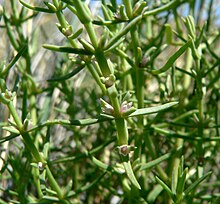|
Polycnemoideae
The Polycnemoideae are a small subfamily of plants in the family Amaranthaceae, representing a basal evolutionary lineage. The few relictual species are distributed in Eurasia and North Africa, North America, and Australia. DescriptionThe subfamily Polycnemoideae comprises small herbs; some species are weakly lignified and grow shrublike. The subfamily is distinguishable from all other members of Amaranthaceae by normal secondary growth. The alternate or opposite leaves are often linear or subulate. The stomata of the leaves are arranged in parallel to the midveins.[1] The bisexual flowers are sitting solitary in the axil of a bract and two bracteoles. The inconspicuous perianth is formed of chartaceous, scarious, white or pinkish tepals. One to five stamens are present with their filaments united in a short but distinct filament tube (like in subfamily Amaranthoideae). Anthers are with only one lobe and two pollen sacs (bilocular, like in subfamily Gomphrenoideae). In fruit, the tepals are never conspicuously modified.[1] Photosynthesis pathwayThe Polycnemoideae are all C3-plants. This is considered a primary character.[1] Distribution and evolutionThe Polycnemoideae are distributed in the temperate regions of Eurasia (central and southern Europe, northwestern Africa, Central Asia), North America, and Australia.[1] Polycnemoideae began to diverge from Amaranthaceae s.str. in Eocene. At the edge from Eocene to Oligocene, the subfamily split into a lineage on the Northern Hemisphere, which was the ancestor of Polycnemum, and a lineage predominantly occurring on the Southern Hemisphere with the ancestors of Nitrophila, Hemichroa, and Surreya. An antarctic connection of these southern ancestors is assumed. The genus Nitrophila developed in South America and dispersed later to North America. The genera of the subfamily diversified during Miocene and Pliocene, with only a few rare species that seem to be relictual.[2] Systematics The intrafamilial position of the Polycnemoideae has long been a matter of dispute. The taxon was recognized in 1827 as Tribus Polycnemeae within the family Chenopodiaceae by Dumortier (In Florula Belgica). Later, it was treated as belonging to the family Amaranthaceae in 1849 by Moquin-Tandon (in Prodromus systematis naturalis.... Vol 13). Oskar Eberhard Ulbrich raised it to subfamilial level in 1934, again within Chenopodiaceae (in Engler & Prantl: Die natürlichen Pflanzenfamilien. Vol 16c). Today, both families are included in Amaranthaceae s.l.[1] Phylogenetic research has revealed the Polycnemoideae represent a basal lineage of evolution within the family Amaranthaceae.[1] The Polycnemoideae comprise only one tribe, Tribus Polycnemeae,[3] with four genera and 13 species:[2]
References
External linksWikimedia Commons has media related to Polycnemoideae. Wikispecies has information related to Polycnemoideae. |
||||||||||||||||||||||||||
